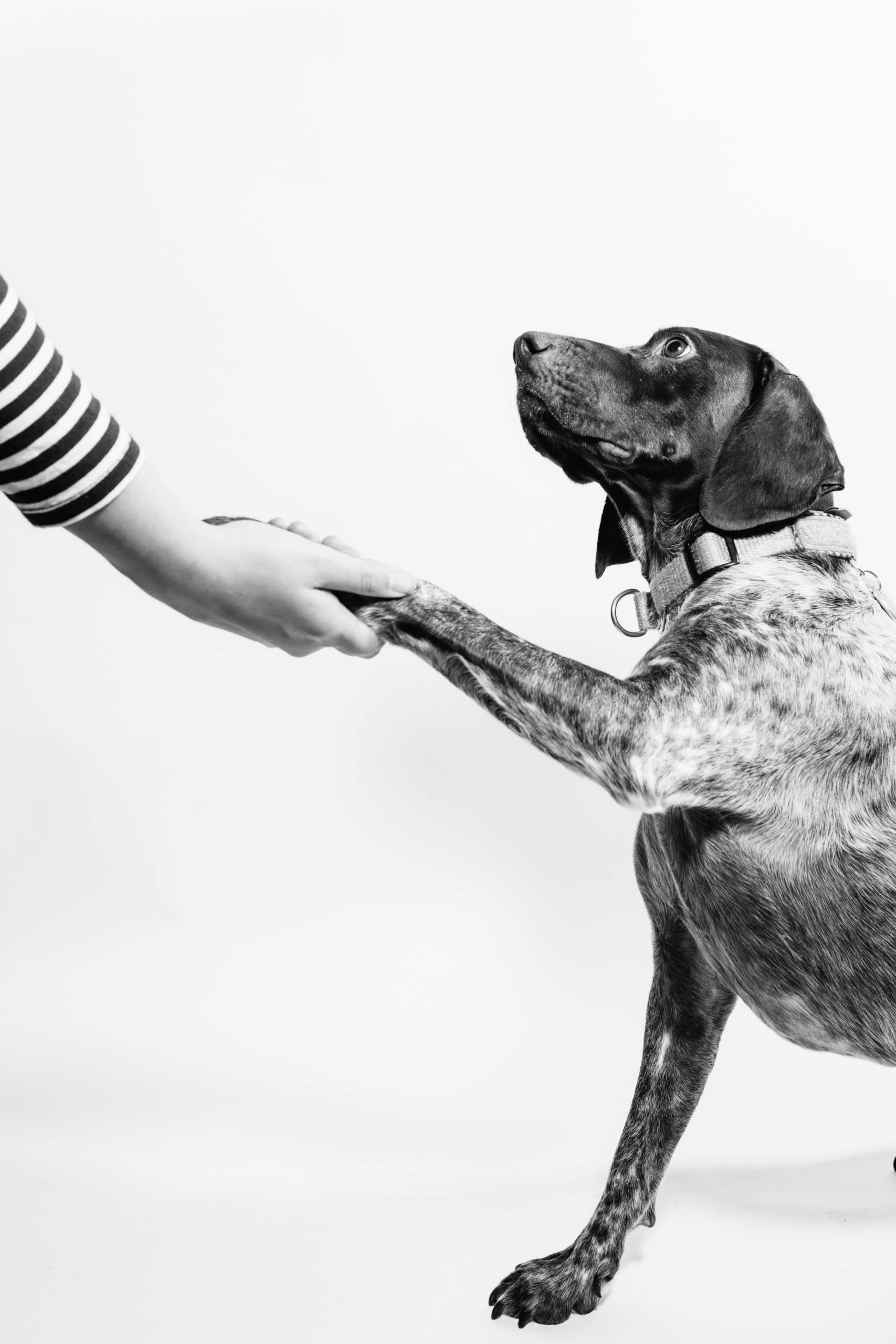Understanding your furry companion’s behavior is essential for a harmonious life together, but sometimes decoding their actions and emotions can feel like solving a complex mystery.
With over 340 different dog breeds, each with unique characteristics and tendencies, it’s crucial to gain insight into what makes our canine friends tick.
This blog will delve deep into the fascinating world of dog behavior as we explore canine instincts, body language, emotional states, breed traits, training techniques, and much more.
Understanding Dog Behavior
Dogs have their own unique instincts and body language, which can be interpreted to better understand their behavior.
Canine Instincts And Body Language
Gaining insight into canine instincts and body language is essential for understanding dog behavior. Dogs communicate with each other and humans predominantly through body language cues, which provide valuable information about how a dog is feeling.
Dog owners should familiarize themselves with various body language signals to better understand their pet’s emotional state and respond appropriately. One fascinating fact about dogs is that they have incredible senses of smell – thousands of times stronger than humans, in fact! This allows them to gather information about their environment by sniffing around.
Recognizing when your dog may be experiencing fear or anxiety can play an important role in preventing undesirable behaviors like aggression – which often stems from these emotions.
By observing facial expressions, ear positions, and overall posture, you can gauge your dog’s comfort level within any given situation.
Behavioral Development Stages
Dogs go through several developmental stages in their lives that can affect their behavior. Here are the stages of dog behavioral development that all dog owners should be aware of:
- Neonatal Stage (0-2 weeks): At this stage, puppies are completely dependent on their mother and littermates for survival.
- Transitional Stage (2-4 weeks): Puppies start to explore their surroundings and develop basic social skills with their littermates.
- Socialization Stage (4-12 weeks): This is when puppies learn critical social skills from interacting with other dogs and humans. Proper socialization during this stage is crucial to prevent future behavioral problems.
- Fear Imprint Stage (8-10 weeks): During this stage, a puppy’s fear response is more pronounced, so it’s important to expose them to a wide variety of people, places, and experiences in a positive way.
- Juvenile Stage (3-6 months): Puppies become more independent and may test boundaries during this time, so it’s essential to continue training and socializing them.
- Adolescent Stage (6 months – 2 years): This is when puppies reach sexual maturity and may exhibit more challenging behaviors like aggression or destructive chewing. Consistent training and exercise can help manage these behaviors.
Understanding each stage of your dog’s development is crucial for promoting good behavior throughout their life.
Common Problematic Behaviors
Many dogs exhibit problematic behaviors that can be frustrating for owners. Here are some of the most common:
- Barking – excessive barking, whether at people or other animals, can be a nuisance and disrupt the peace.
- Chewing – destructive chewing of household items or furniture can be costly to replace and dangerous if dogs swallow non-edible objects.
- Jumping up – jumping on people can be intimidating and potentially harmful, particularly to small children or elderly individuals.
- Digging – digging holes in lawns or gardens can ruin landscaping and make yards look unkempt.
- Separation anxiety – dogs with separation anxiety may exhibit destructive behavior when left alone, such as excessive barking or destruction of property.
- Aggression – aggression towards people or other animals can be dangerous and must be addressed promptly.
Understanding these behaviors and their root causes is crucial to effectively managing them through training techniques or seeking professional help if necessary.
The Science Of Understanding Dog Behavior
The science of understanding dog behavior includes factors such as breed tendencies, past experiences and emotional states, and can be used to improve a dog’s behavior through positive reinforcement training techniques, consistent routine and discipline, exercise and mental stimulation, and addressing underlying medical issues.
Breed Tendencies And Personality Traits
Understanding your dog’s breed tendencies and personality traits is essential in effectively training and communicating with them. Different breeds have been bred for specific functions, such as hunting, herding, or guarding.
Personality traits also vary among breeds and even individual dogs within the same breed. Some breeds are known to be more outgoing and friendly towards strangers, while others may be naturally reserved or protective of their owners.
It is crucial for pet owners to research their dog’s breed characteristics before bringing them into their household. This knowledge can aid in understanding potential behavioral issues that may arise and how best to address them through proper training techniques.
Past Experiences And How They Affect Behavior
Dogs, much like humans, are a product of their experiences. A puppy’s early socialization and training play a significant role in shaping its behavior as an adult.
Moreover, negative experiences such as abuse or neglect can have long-lasting effects on a dog’s behavior.
Understanding your pet’s past experiences is crucial in addressing any problematic behaviors. Adopted dogs may have had traumatic pasts that require patience and understanding from their new owners when it comes to training and behavior modification.
Overall, recognizing how your dog’s past influences their current behavior enables you to take the necessary steps to provide them with the support they need while ensuring they feel comfortable and secure within your family unit.
Recognizing Emotional States In Dogs
As a dog owner, it’s important to be able to recognize your pet’s emotional states in order to address any underlying issues and prevent problematic behaviors. One way dogs communicate their emotions is through body language, with cues such as tail position, ear movement, and facial expressions indicating different emotional states.
Another way to recognize your dog’s emotional state is by paying attention to their behavior. Dogs who are anxious or stressed may pant excessively, pace back and forth, or engage in destructive behaviors like digging and chewing.
By understanding the emotions behind your dog’s behavior, you can work on addressing any underlying issues through positive reinforcement training techniques and providing ample exercise and mental stimulation.
How To Improve Your Dog’s Behavior
Improve your dog’s behavior by using positive reinforcement training techniques, establishing a consistent routine and discipline, providing ample exercise and mental stimulation, and understanding and addressing underlying medical issues.
Positive Reinforcement Training Techniques
Positive reinforcement is one of the most effective ways to train a dog, and it involves rewarding good behavior rather than punishing bad behavior. Here are some positive reinforcement training techniques that can help improve your dog’s behavior:
- Treats: Use small, healthy treats as a reward for good behavior. When your dog performs a desired action, such as sitting or lying down, give them a treat immediately.
- Clicker Training: Clicker training involves using a clicker to signal to your dog when they have done something right. This sound becomes associated with receiving a reward and quickly becomes an effective way to train.
- Verbal Praise: Dogs respond well to positive verbal feedback from their owners. Use encouraging phrases like “good job” or “well done” when they display good behavior.
- Playtime: Some dogs respond best to playtime as a reward for good behavior. Spend time playing with your dog after they complete a task correctly.
- Consistency: It’s important to be consistent with your rewards so that your dog understands what behaviors are desirable and what actions will result in rewards.
By consistently using positive reinforcement techniques, you’ll find that your dog becomes more responsive and obedient over time. Remember that every dog is different, so experiment with different types of rewards and pay attention to what works best for your pup! You can seek professional training if you feel stuck!
Establishing A Consistent Routine And Discipline
Consistency is key when it comes to establishing good behavior in your furry friend. A regular routine for feeding, exercise, and playtime can go a long way in maintaining discipline.
Dogs thrive on predictability so it’s important to create a schedule that works for both you and your furry pal.
For example, if you don’t want your pup on the couch, consistently redirecting him or her to their own bed reinforces this rule. Another tip is to use positive reinforcement techniques like praise or treats when they follow commands correctly.
This approach not only encourages obedient behavior but also strengthens the bond between the pet and the owner.
Providing Ample Exercise And Mental Stimulation
It’s important to provide ample exercise and mental stimulation for your dog to improve their behavior. Regular exercise helps to release pent-up energy, reduce stress, and increase overall well-being. This can be achieved through activities such as walks, running, or playing fetch.
Dogs are social animals and need interaction with other dogs or humans regularly. Socializing your dog early on can prevent problematic behaviors from developing later on in life.
Research has shown that providing both physical exercise and mental stimulation leads to fewer behavioral problems, like digging holes in the yard, excessive barking, chewing on inappropriate objects, or destructive behaviors indoors.
Understanding And Addressing Underlying Medical Issues
It is essential for dog owners to consider underlying medical issues when addressing problematic behavior in their pets. Some dogs may exhibit sudden changes in behavior due to pain or discomfort resulting from an undiagnosed injury, illness, or chronic condition.
Therefore, it is crucial to take your pet for routine check-ups and vet visits and be observant of any signs of changes in its health status. This can help in identifying underlying conditions that could be contributing to negative behaviors.
Additionally, medication can also be prescribed by veterinarians to treat some behavioral issues such as separation anxiety and phobias that have no apparent cause-related tags; this option usually goes hand-in-hand with ongoing training programs that aim at reinforcing desirable behaviors while eliminating bad habits like chewing shoes or destructive digging outbursts during anxiety episodes.
Seeking Professional Help For Problem Behaviors
If your dog is exhibiting problematic behaviors despite your best efforts, it may be time to seek professional help from a veterinarian or dog behaviorist who can provide expert guidance and support in addressing those issues.
When To Seek Help From A Veterinarian Or Dog Behaviorist
If your furry friend is exhibiting problematic behavior, it’s crucial to seek professional help as soon as possible. Some signs that indicate you should consult with a veterinarian or dog behaviorist include excessive barking, destructive chewing, biting or aggression towards humans or other animals, and sudden changes in temperament.
A veterinarian can rule out any underlying medical issues that may contribute to behavioral problems. A dog behaviorist specializes in understanding the nuances of canine psychology and can develop a customized training plan tailored for your pet.
Remember that early intervention is key when it comes to addressing problematic behaviors before they become entrenched habits.
Understanding The Benefits Of Seeking Professional Help
Professional help can be immensely beneficial in addressing problematic behaviors or issues with your furry friend. Dog behaviorists and veterinarians have extensive training and experience in understanding canine psychology, which allows them to identify the underlying causes of behavioral problems accurately.
Apart from providing long-term solutions for bad behaviors such as aggression, fear, anxiety, or separation anxiety disorders that are explained by dog psychology research you may not readily find online; seeking professional guidance also saves pet owners time and effort spent trying out ineffective techniques such as punishment-based training methods.
It’s essential to understand that every dog is unique and may require specific attention to appropriately address each issue.
In addition to addressing problem behaviors, seeking professional help also promotes healthy relationships between pets and their owners.
What To Expect During A Behavior Consultation
During a behavior consultation with a veterinarian or dog behaviorist, you can expect an in-depth assessment of your dog’s behavior. The professional will look at your dog’s medical history and any medications they are taking before asking questions about your dog’s routine, temperament, and past experiences.
Based on their findings, the professional will provide personalized recommendations for improving problematic behaviors using positive reinforcement training techniques.
It is important to remember that every situation is unique.
Conclusion
Understanding dog behavior is crucial for any pet owner looking to build a strong and healthy relationship with their furry friend. By recognizing canine instincts, body language, and emotional states, owners can address problematic behaviors proactively.
Positive reinforcement training techniques and establishing consistent routines will go a long way in improving your dog’s behavior. Seeking professional help during difficult times like separation anxiety or aggression is a responsible move most pet owners take.
FAQs:
1. How can I tell if my dog is happy or stressed?
Signs of a happy dog include wagging tails, relaxed ears, and body language, while stress may be indicated by pacing, excessive barking or growling, and avoidance behaviors such as hiding.
2. Why do dogs exhibit destructive behavior?
Destructive behavior in dogs can occur due to a variety of reasons such as boredom, anxiety resulting from separation anxiety, or fear of new surroundings. Additionally, it could be indicative of under-stimulation and/or insufficient exercise routines within the home environment.
3. What are some common behavioral problems that dogs develop?
Canine behavioral issues may range anywhere from minor irritations such as chewing on household items (like shoes) to more severe problems like aggression towards other animals/humans. Unwanted urination/defecation within indoor spaces is another commonly cited issue among pet-parents.
4. Are there techniques that can help correct problematic canine behavior?
The correction process for canine misbehaviors typically involves many different strategies dependent upon type/severity/etc., but usually, corrective measures involve identifying cause(s) behind certain actions and then discouraging/reinforcing specific behaviors through training exercises focused on positive reinforcement methods.
Working with certified animal behavioral experts/trainers can also bring insight and added benefits compared to just doing things alone based on internet research & opinions..



